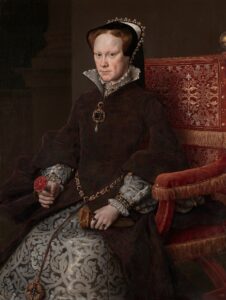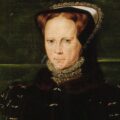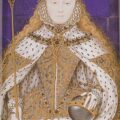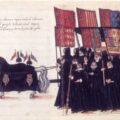
At 11am, Mary processed into the Abbey, dressed traditionally, as a male monarch would be, in the usual state robes of crimson velvet. Before her, processed the Bishop of Winchester, gentlemen, knights and councillors, the Earl of Arundel carrying the ball and sceptre, the Marquess of Winchester carrying the orb and the Duke of Norfolk carrying the crown. A canopy carried by the barons of the Cinque Ports was carried over the Queen as she processed along a raised walkway to the coronation chair.
Gardiner opened the ceremony with the following address:-
“Sirs, Here present is Mary, rightful and undoubted inheritrix by the Laws of God and man to the Crown and Royal Dignity of this realm of England, France and Ireland, whereupon you shall understand that this day is appointed by all the peers of this land for the consecration, injunction and coronation of the said most excellent Princess Mary; will you serve at the time and give your wills and assent to the same consecration, unction and coronation?”
To which the congregation replied: “Yea, yea, yeah! God save Queen Mary!”
As was usual for the monarch, Mary then prostrated herself before the altar on a velvet cushion while prayers were said over her. Afterwards, the Bishop of Chichester, George Day, preached a sermon on the obedience owed to a monarch and then Mary made her oaths before lying prostrate once again in front of the high altar while the Abbey choir sang “Veni Creator Spiritus”. Accompanied by her ladies, Mary then went to change in preparation for her anointing. Dressed in a petticoat of purple velvet, she lay in front of the altar and was anointed with holy oil on her shoulders, breast, forehead and temples by Gardiner. Once again dressed in her robes of state, Mary then received the sword, the sceptre and orbs, and was crowned with crown of Edward the Confessor, the Imperial Crown and then a specially custom-made crown. The ermine furred crimson mantle was then put about her shoulders and she then sat in the coronation chair as nobles paid homage to their new queen.
Finally at 4pm, Mary walked out of Westminster Abbey, processing to Westminster Hall for the coronation banquet, where she was joined by her half-sister, Elizabeth, and her former step-mother, Anne of Cleves. There was much to celebrate. Mary was now the recognised queen of the realm, the first crowned queen regnant of England. Mary Queen Mary I.
Source
- Mary Tudor: Princess, Bastard, Queen, Anna Whitelock, p209-211





By the time Mary made it to the throne of England she had been too damaged from disfunctional lifestyle. Can you only imagine the feelings that she stored up throughout her young life. All of it had to peak out at some point and the seams of her life split right about the time she was crowned Queen of England. From that point onward it was down hill for poor Mary. The cherry on top was unloving husband she hooked up with out of desperation. Everyone left her or was taken away from her, even her husband.
I always thought that the portrait of Mary showed someone who may have been a survivor, but she looks sad and so different from the young girl that she used to be. She survived losing her title as princess and becoming a bastard, she survived the official loss of her religion, and then she had to deal with her much younger brother telling her what to do, Not a good way to start your reign as the first crowned queen of England. I do not think she was prepared for the role of a monarch and probably expected a husband to help her. And that was a huge problem for her because at her age most Tudor women were already married for a long time and already had children. Having to produce an heir at her age must have scared her. She relied too much upon the Holy Roman Emperor and that was a mistake as well. Cardinal Pole did not help matters and he had been out of the country for too long to know what the current political and religious state the country was in. I think she relied on the advice of others too much and those advisors were not the best choice. Yet she did show that a woman could rule England and that must have helped pave the way for Elizabeth to take the throne.
While it is extremely necessary to remember Mary’s extremely troubled and horrid past, it isn’t right to say she is one to be merely pitied, for all the peril and the distraught formed a woman so strong as to subdue or fight on key with all and any that dared to try and look down on her. Anne Boleyn; Mary was the only one ( not even bold king Henry) to challenge her, and shoot her down at every turn. Henry; she fought with probably the most dangerous king of England for years and years until finally her life was in true danger. She fought Katherine Howard; why, no one truly knows, but it is speculation that she may have heard of her dubious reputation, and she was younger than Mary. All of Edwards regime was her enemy, specifically the most powerful of men: Edward and Thomas Seymour, and even her dear brother Edward who was like her son. At one point Mary fought the whole parliament, most of them becoming so exasperated in her political correctness and skill in debate that they pulled an Anne Boleyn and started cursing at Mary and throwing fits. And probably her second most threatening rival, said to be the only other man she feared besides her father, John Dudley. He was a much skilled opponent but Mary even triumphed over him.
These enemies were not your everyday pushovers, they held real power, a power over even the heiress to the thrown, that she was able to even stand her ground shows a great woman, as even most men would have cowered in fear. The strain and pain of her years proved not only to be a curse that emotionally scarred her, but a cruel blessing that made her strong.
Mary’s reign is the opposite of a failure, it was a partly fulfilled dream thats benefits were reaped by a younger sister who became known as the ‘Virgin Queen’. Could Mary’s reign be called a failure? Many historians argue that if Mary would have ruled for evenhalf the time Elizabeth ruled, England would still be Catholic today and her reign would have been the ‘Golden Age’ of England. The doctrines and legislation passed during her reign were not just of religious sentiment (as most would like to claim) but political uniformity, that would help her younger sister in ways she could only imagine.
I personally recommend ‘Bloody Mary’ by Carolly Erickson, it is both extremely insightful and has minimal bias. It pretty accurately describes the life of Mary before the crown and has a more in depth view of her reign and the different factors that had the biggest impact on it.
Enjoyed reading this, quite very good stuff, thankyou .